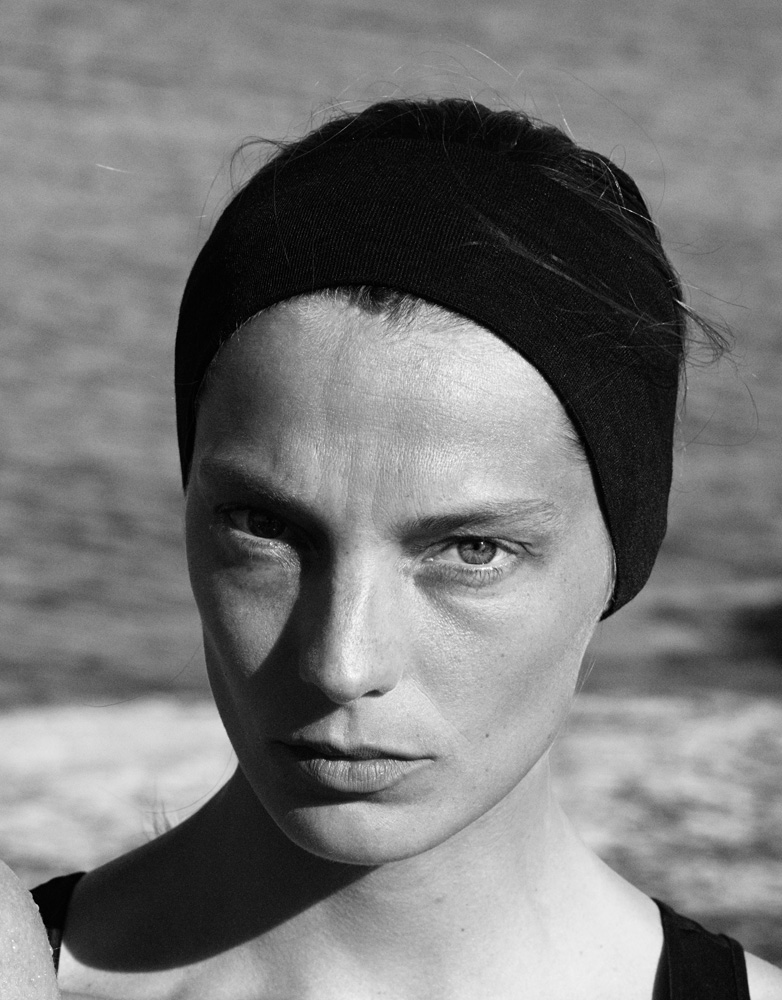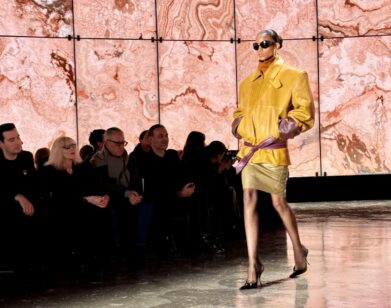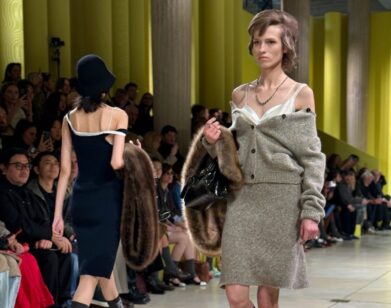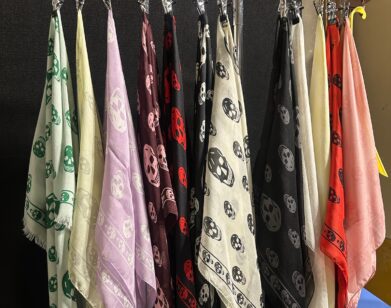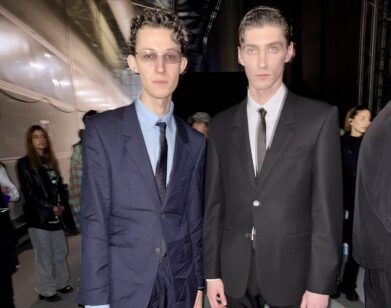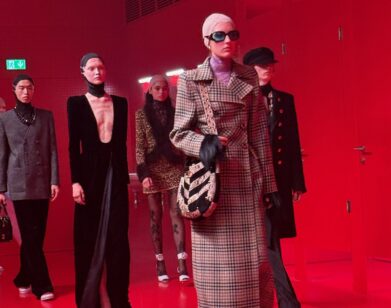Daria Werbowy by Mikael Jansson
I LIKE TO CAPTURE the MOMENT. I DON’T WANT to OVERDIRECT, THAT’S FOR sure. I LIKE to STAND BACK and SEE WHAT’S GOING to HAPPEN. Mikael Jansson
One finds a variety of stylistic threads within the extensive body of work of Swedish-born photographer Mikael Jansson—from sun-kissed beachscapes to moody black-and-white portraits to high-wattage glamour shots. But Jansson’s frequent subject, Canadian supermodel Daria Werbowy, whom he first photographed for Numéro in 2003, sees what ties it all together. “You like women,” she says to him at the beginning of their conversation. It was a woman who, way back in the 1970s, when Jansson was photographing concerts in Stockholm as a hobby, gave him his first break. A model he met waiting in line for David Bowie tickets hooked him up with his first job as an assistant to photographer Carl Johan Ronn. And for five years, Jansson honed his craft with Ronn, before moving to New York and landing a gig as an assistant to Richard Avedon.
Thirty years later, Jansson is still based in New York, though he frequently shoots in exotic locales for an international roster of big-name publications and brands like Louis Vuitton, Chloé, Calvin Klein, and Diane von Furstenberg. Unlike many of his contemporaries, he’s not a star on social media and doesn’t relish giving interviews, making him a photographer whose work everyone has seen, yet one whom few know by name.
In July, Jansson returned to Sweden, to his summer cottage on an archipelago near Stockholm, and to Werbowy, whom he photographed outdoors, in various states of undress. The final photo shows Werbowy posing with a poster for I Am Curious (1967), the controversial Swedish film that was banned for its portrayal of nudity and sexuality—and is still a good starting point, Jansson says, for a discussion today.
DARIA WERBOWY: Why don’t we start with why you decided to include the picture from I Am Curious.
MIKAEL JANSSON: I thought it would be nice to talk about nudity. I grew up in Sweden around that whole ethos—the comfort with nudity.
WERBOWY: And you take a lot of nudes. For me, I’m very comfortable nude with you. You have a perception of women that I think women appreciate. It’s very different from a random picture of a woman naked. Your perspective is more romantic and more respectful of the female body. It comes from a nice place. So, you obviously saw I Am Curious when you were younger. It was banned in a lot of places.
JANSSON: It was banned, but I think it was also the 12th most seen film in America in 1969.
WERBOWY: Nudity seems to be an issue that America can’t get over in general. I wonder when the day will come when we finally become okay with it, with the human form.
JANSSON: Things are going backwards, in a funny way.
WERBOWY: When did you get interested in photography?
JANSSON: I got my first camera when I was 11. By 15 or 16, I had my own darkroom in the closet. I started taking a lot of pictures of bands that came to Stockholm. I met this girl when we were lining up for tickets for David Bowie. We slept in sleeping bags for three days and three nights outside the ticket office. The girl, who worked as a model, said, “Oh, I know a photographer who wants an assistant.”
WERBOWY: Why do you think you liked Bowie so much?
JANSSON: I thought he was brilliant. I never photographed him and I always wanted to. I did this series of portraits of Iggy Pop, Lou Reed, and others, and we tried to get Bowie but he wasn’t available. Iggy was superb and easygoing. He gave so much, like an entire concert. He said to his assistant, “Why don’t you run out to the car and get the album Raw Power?” We put it on in the studio and he was just bouncing off the walls in there.
WERBOWY: And then another big part of your career was assisting Avedon.
JANSSON: I worked as an assistant in Stockholm for five years. The photographer was amazing and he taught me about Avedon and Penn and Cartier-Bresson. So I decided that I wanted to go to New York and work for Avedon.
WERBOWY: Careful what you wish for, right?
JANSSON: Exactly. I bought a ticket to New York, and my first phone call was to Avedon’s studio. They said, “We don’t need anyone now, but send a résumé.” So I did. I was freelancing in New York for two months when they called me. I went to three different interviews, and then I got the job and worked there for two years with him.
WERBOWY: What was that like?
JANSSON: It was a fantastic experience. But you had to connect with him outside of photography. I was really into jazz, so I brought my music to the studio and he loved it. So he said, “Mikael is in charge of the music.” I had shot Chet Baker in Sweden once before. I showed the picture to Avedon, and he said he wanted to photograph Chet. He said, “Let me know when Chet is playing next time.” I said, “He’s playing at a small jazz club downtown.” He said, “Mikael, to be a photographer, you have to do these kinds of things.” He sent me to the club to ask Chet if I could take his picture.
WERBOWY: With fashion now, we don’t get as much time to work on something as we normally would.
JANSSON: It’s less and less for sure. When I started, people traveled more. You went to a place for a week and took pictures. But now it’s very tight schedules.
WERBOWY: We were lucky in Sweden with the summer days, 16 hours of daylight.
JANSSON: It made a difference, I think, in the way the pictures came out.
WERBOWY: It felt different. It didn’t seem like there was as much pressure to check the boxes that we sometimes have to these days. What is the wildest, funniest, craziest time you ever had on a shoot?
JANSSON: Well, the nicest time I’ve had on a shoot was probably the one we just did. [both laugh]
WERBOWY: I was going to say, “Don’t say, ‘The one we just did.’ ” When we went to your cottage by the lake, I felt like I was going back in time—like I was in an old Swedish movie with all the little boats going by. We forget that people live that way still, and we seem to think that it’s so long ago and our lives are so quick and so fleeting and fast, and we come and go to all these places. But people do live well and happily and have nice lives in places like that. That jazz musician we were listening to while we were shooting, Jan Johansson—I’ve been listening to that nonstop.
JANSSON: I got that album when I was 15 and I’ve been listening to it ever since.
WERBOWY: After we finished shooting, I walked around Stockholm listening to it. They should play that music while you look through the magazine. When you’re taking a picture, how involved are you?
JANSSON: I like to capture the moment. I don’t want to overdirect, that’s for sure. I like to stand back and see what’s going to happen.
WERBOWY: That’s much more difficult these days with fashion, isn’t it?
JANSSON: But there are those little moments in between—like, if you’re doing hair and makeup, and I steal a moment right after. There are always moments.
WERBOWY: Why don’t you like doing interviews?
JANSSON: I think it’s because I’m not that good verbally. I like to take pictures; it’s like hiding behind a camera.
WERBOWY: There’s truth to that. Words are difficult and photography takes the words away from things. It’s difficult to talk about something that seems to come very naturally to you, to explain a process. A moment is really difficult to put on paper.
JANSSON: It happens in a funny way. Oh, we have to talk about the retouching, because I think you look so amazing that I haven’t touched the pictures.
WERBOWY: I like that. It’s so refreshing. Where do you think the obsession with retouching comes from?
JANSSON: We get carried away with the technique and with what you can do. You get sort of blind.
WERBOWY: Girls don’t have knees anymore. Have you noticed that? I didn’t know people thought knees were so ugly, but they wipe out all the knees. It’s all kneeless people. I think it looks so great to see the real person. I’m not 14 anymore, and I think it’s so much more of a celebration of the human existence to see it the real way.
JANSSON: I always loved that—to show the person and their character. You know me.
DARIA WERBOWY IS A UKRAINIAN-CANADIAN MODEL.
For more from the Photographers’ Portfolio, click here.

